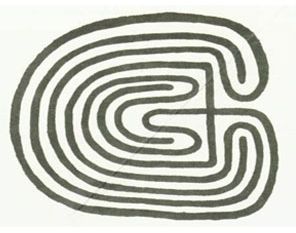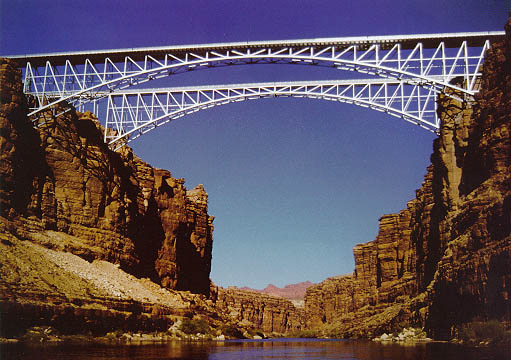Blue Highways: Cedar City, Utah
Unfolding the Map
Click on Thumbnail for MapCedar City is the place where William Least Heat-Moon (LHM) felt that he got one of his most important interviews in Blue Highways. In this post, we take another look at the concept of journeys and destinations. Click on the thumbnail at right to see all our little journeys, wrapped up in a bigger journey, all making up a small part of our biggest journey called life.
Book Quote
"The key seemed to be emergence. Carved in a rock near the village of Shipolovi is the ancient symbol for it:
Hopi emergence symbol. Photo at Aistear InisCealtra Online.
Click on photo to go to host site.
"With variations, the symbol appears among other Indians of the Americas. Its lines represent the course a person follows on his "road of life" as he passes through birth, death, rebirth. Human existence is essentially a series of journeys, and the emergence symbol is a kind of map of the wandering soul, and image of a process; but it is also, like most Hopi symbols and ceremonies, a reminder of cosmic patterns that all human beings move in."
Blue Highways: Part 5, Chapter 4
 Downtown Cedar City, Utah. Photo on Wikipedia. Click on photo to go to site.
Downtown Cedar City, Utah. Photo on Wikipedia. Click on photo to go to site.
Cedar City, Utah
Why am I going back to the Hopi when I spent a good four posts on them? Why don't I just write about Cedar City? Unfortunately, LHM doesn't spend much time on the town, and I've never been there - though reading about it I'd like to go see some of the sights in Cedar Breaks National Monument and perhaps see the Shakespeare Festival there.
In Blue Highways, when LHM stops in Cedar City he gets some breakfast at the campus of Southern Utah State College. While eating, he strikes up a conversation with a Hopi man named Kendrick Fritz who is studying medicine and who wants eventually to go back to the Hopi homeland to help his people.
In an interview with Artful Dodge, LHM says that there were three interviews that were most important to him. One was at the Monastery of the Holy Spirit in Georgia with Brother Patrick. We have already been there on our literary journey. One is with a person we have yet to meet. His interview with Kendrick Fritz was another of the three interviews that he felt most important. I think that it was because the whole idea of how journeys fit into our lives came into focus for him.
The quote above captures the essence of what LHM is discovering on his trip. Life is a series of journeys that we make separately for ourselves and together with others. All of those journeys that we make can be combined to additively make our life's journey. The Hopi encapsulated all of that into a maze symbol. We essentially wander around looking for our purposes, or our meanings. We are sometimes lost, and sometimes we know our way. Through it all, we continue our journeys until we are called to a new world.
The way I think of it, we are journeying all the time, whether we like it or not. In my lifetime, I will make a number of journeys on Earth, whether it's to my corner store, or the trip to Turkey that I will be making in about three weeks. But even as I sitting here on my couch typing on my laptop, I am journeying. In my lifetime, without really being too aware of it other than watching the years come and go, I will have made a certain as of yet unknown number of rotations around the sun, journeying in circles for the length of my existence. The sun itself will be traveling along with other stars in the galaxy as the Milky Way continues to move outward and away from its existence. The universe continues to expand, and we are all taking part in that journey, even though we only see a small piece of it.
The journeys don't have to be physical. I have taken a number of emotional journeys in the past two years, some of which were not good, some of which were very good. From all of them I will learn. I've taken professional journeys recently as well, and will continue to hope that they all mean movement forward toward some kind of goal. I continue to try to journey spiritually, though I don't feel I'm very successful at it. This blog is a journey: Not only does it map my reading journeys, but it also is a journey in itself as I don't really know where it will lead me.
As I write, it's Easter Sunday. I was raised to believe, in the Catholic tradition, that this is the most important holiday, supposedly even more than Christmas though it was hard to convince me because we got presents on Christmas. Even this day, however, is a celebration of the culmination of one man's journey through a short but incredibly meaningful and important life, and the beginning of a journey for a new faith that would one day become one of the major religions.
We tend to think of journeys as a starting point and ending point with points of interest in between. We make lots of them, even if we aren't aware sometimes what kind of journey we are on. All of the journeys we make are bracketed by the start and end points of our lives, the ultimate journeys of our existence. The point of a journey is, to me, accomplishing something and learning from it. The journey of Kendrick Fritz, the Hopi who gave LHM such an important interview, has brought him back to the Hopi to serve his people as a medical technologist. The journey of LHM in Blue Highways brought him fame and fueled his desire to write an even more personal and in-depth account, in a book called PrairyErth, of a journey in a small corner of Kansas. If I can accomplish and learn something on my journeys so that they add up to a well-lived and meaningful life, then I will have made the most of my time on Earth.
Zia has it right. The journey IS the destination!Even as I think of all these journeys, however, I am tempted to want to journey like my wonderful little dog. Zia jumps into a journey at a moment's notice, whether we are just going for a walk, or if we are getting in a car. She doesn't know where we're going - it really doesn't matter. For her, every journey is the best journey. My good friend Vickie, who is a very wise person, told me recently of her revelation that the journey is the destination. I was trying to figure out what she meant by that, but watching Zia's happiness and contentment when we are going somewhere, I think I understand. For Zia, the journey is the joy. It is her destination, and where she's at peace. I wish I could look at all my journeys that way, instead of being so caught up in where I think I need to be. Yes, I want to reach goals, but my journeys are also best when I just enjoy the experience of the movement.
Musical Interlude
Today's musical interlude is Light Enough to Travel by the Be Good Tanyas. I picked this song not so much because of the lyrics but because of the title. I think sometimes the things that makes our life's journeys more difficult is the baggage we carry along with us. All the should haves and would haves and unmet expectations and perceptions of failure. When I go on a trip, I spend time thinking about what to pack - what do I need and want etc. I plan and plan. And like I said above, my dog just gets into the car, ready to go. We all need to keep it light enough so that we can travel with as few burdens on us as possible and enjoy our journeys in life to the fullest.
If you want to know more about Cedar City
Cedar City Daily News (newspaper)
CedarCity.com
Cedar City Official Website
Southern Utah University
Utah.com: Cedar City
Wikipedia: Cedar City
Next up: Pioche, Nevada




 Sunday, April 24, 2011 at 9:11AM
Sunday, April 24, 2011 at 9:11AM

